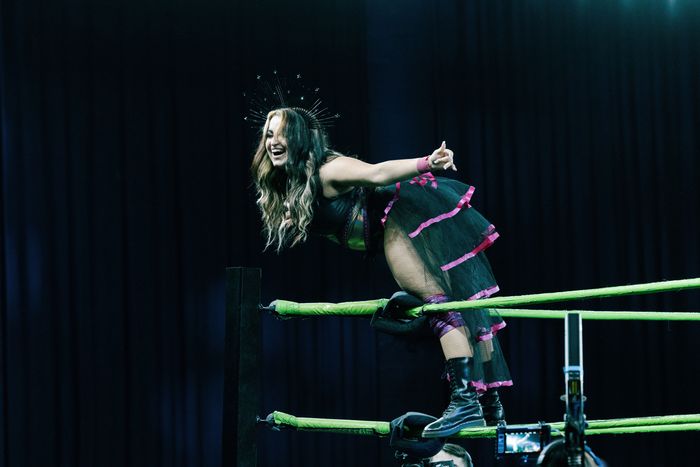
Like any good inspirational sports tale about a ragtag group of misfits with big dreams, Monster Factory, Apple TV+’s new documentary series about the eponymous wrestling school in New Jersey, begins by establishing the Big Game that shapes the season’s arc. In the first episode, Danny Cage, the owner and head coach of the Monster Factory, announces the school will be putting on a showcase at the 2300 Arena in Philadelphia — a legendary pro-wrestling venue — attended by representatives from Impact, New Japan Pro Wrestling, and All Elite Wrestling. It’s a massive opportunity for the Factory’s students, each of whom is vying for a chance to sign with a company that can pay them enough to quit their day jobs and perhaps one day become pro wrestling’s next big thing. Among them is Luke Disangro, whose Tourette’s syndrome inspired his ring name, Twitch. Amelia Herr chose wrestling in angel wings as the Notorious Mimi over a traditional suburban princess life. Goldy is a confident jock persona inhabited by David Goldschmidt, who has lived his whole life with crippling anxiety. Gabrielle Belpre wrestles under Gabby Ortiz, the maiden name of the mother who died just before she started her career. Hurley A. Jones Jr., the Factory’s 335-pound reigning heavyweight champion, goes by the ring name Bobby Buffet and encourages his many fans to chant “Eat! Eat! Eat!” as he shakes the ring so hard his opponents fall to the ground.
“Most people that find wrestling are running from something,” Cage tells Vulture. “It’s looking for something to grasp onto, some kind of hope, and then all of a sudden it’s like, Oh, there’s a wrestling school. I can go be that superhero I look up to.” And it’s their belief in this ability, as the show consistently reminds us, that’s as brave as it is precarious.
Much like its Apple TV+ sibling Ted Lasso, Monster Factory wants viewers to stay optimistic. But wrestling is not a regular sport, where a positive mind-set might be all you need to round out your game-winning skills. So while Lasso is free to overdose on the sweetness of sportsmanship even in the face of loss, Factory has no such luxury. A dark truth underpins every scene: Wrestling is actually a branch of the entertainment business, one so insular it would be easier to list wrestlers who aren’t nepo babies, so making a living at it is really, really hard. This is not a game where a wrestler can pull off an unlikely win simply by being good and not getting discouraged. Behind the scenes, promoters and bookers decide the winners and losers based on story lines or even just backstage politics. While a soccer team can lose a match fair and square, meaning there’s always room for hope, wrestlers can have their whole careers taken away because one guy got a little annoyed with them. In the face of such unfair odds, to actually chase dreams of wrestling stardom requires a level of courage society could very well deem delusional, a fact Monster Factory punctuates with repeated use of the Phil Collins single “Take Me Home,” a song famously inspired by One Flew Over the Cuckoo’s Nest.
Wrestlers and athletes do share one major concern: career-ending injuries. Cage knows this all too well — his own time on the indie-wrestling circuit was cut short by a back injury — and the pain of that loss fuels his method, one that stresses physical safety but also acknowledges that some of the most dangerous injuries are mental. When Belpre suffers a blow to her elbow, Cage describes her as “hurt, not injured,” noting the difference is largely one of pride. “I’m over proving myself to people,” she tells the camera, before Cage walks her outside for a reality check: “I’m always going to be honest with you: You were good. Right now, you’re not.” It’s a heavy moment, where Belpre is reminded that all her past successes are only meaningful if she uses them to motivate an even harder career push, one she’s not sure she’s up for.
Belpre’s exhaustion is understandable when you appreciate how much each student has to do both in and out of the gym. An appearance by Monster Factory graduate and current AEW star Q.T. Marshall lays out the package of skills every indie wrestler must master in order to have any hope of success, like a report card with six sections: their look, their gear (what they wear, some of which is homemade), in-ring (the actual wrestling part), how well they promote themselves on social media, their backstage demeanor with other wrestlers and promoters, and, finally, promos.
“You’re boring as fuck now,” Cage calls out to Herr as she attempts to cut a promo in episode one. Cutting a promo is wrestling lingo for anytime a wrestler speaks in character; they’re often monologues performed to generate excitement for a match or move a story line forward. Wrestlers must write and perform these regularly, and they’re Herr’s weak spot as a performer. This is bad, because she has a WWE tryout coming up. As she stands in the ring with a mic, addressing a crowd of her fellow students, Cage paces in front of it, shouting feedback like, “That was the worst one!” For a writer, this is a nightmare; for a wrestler like Herr, it’s better than being jeered — or worse, ignored.
While we’re no longer asked to pretend wrestling isn’t staged combat, it is still very much a child of the circus and maintains its own version of reality where, if a camera is rolling, you can pretty much assume whatever is happening is a “work” (wrestling’s term for a scripted part of the show). This requires wrestlers to be “on” pretty much whenever we’re seeing them, which creates an interesting dynamic when dealing with what is ostensibly a documentary. I asked Cage and his students about this: Were they being themselves in the series, or were these their characters? The answer is complicated, since many wrestling gimmicks are subtle enough to align with what we’d now just consider someone’s public persona, a thing anyone with an Instagram account technically has.
“My intention going into it was to be my most authentic self, and a part of my authentic self is my character” Belpre says. “I don’t think any of us are too far from our gimmicks,” Goldschmidt adds. “I am Goldy to an extent; it’s just my real self is just a less-confident Goldy.” In the series, Cage puts it succinctly: “In the acting world, you have to seek out a part; in pro wrestling, you write your own part — you become who you envision yourself as being.” Belpre adds that the Monster Factory encourages students to train out of character in part due to Cage’s distaste for “living the gimmick.” “It’s not healthy to be somebody else,” he tells me. “If I ask you how you’re doing, I want an authentic answer.”
With so much of their personas based on themselves, watching these performers develop their skills on Monster Factory comes across as more of an exercise in self-actualization than character development. As the factory’s reigning champ, Jones must overcome his shyness and go door-to-door promoting himself and the Factory’s weekly show. Disangro needs to evolve his promo skills for the big event, and in doing so overcome his fear of being bullied by a potentially unsupportive crowd. Goldschmidt laments that taking his next big career step means having to move away, leaving behind the only friends he’s made in his life. Meanwhile, Belpre is at a crossroads: She’s entering her late 20s in a youth-obsessed industry where grown women — and, let’s face it, women in general — are harder to commodify. Herr’s early successes push her into an insecure headspace that’s as relatable as it is heartbreaking.
In characteristic Apple TV+ fashion, Monster Factory gives us only six episodes, so it necessarily leaves a lot out. For instance, Belpre and Herr assured me they’re very good friends in real life, though the show doesn’t have time to explore their relationship or the lives of the almost 40 other students we see glimpses of at various points. It’s this brevity that makes this series an easy entry point for newer wrestling fans, but also, frankly, demands a second season.
Though the students of the Factory probably have more in common with stand-up comedians or drag performers than anyone you’d meet in an Olympic Village, this is ultimately what makes the series so endearing. You don’t have to like sports or even wrestling to appreciate what these students are chasing, you just have to be someone who understands what it’s like to dream of a life bigger than the one you have. “We’re all insane,” Belpre tells me. But every student at Monster Factory seems sane enough to understand their dreams have a high chance of imploding at any moment. Their willingness to show up every day anyway? That’s what actually makes them superheroes.


